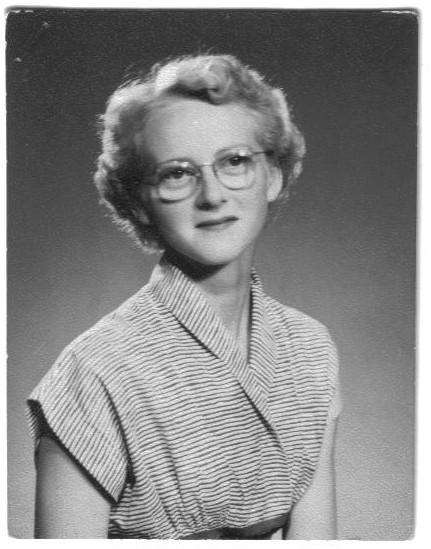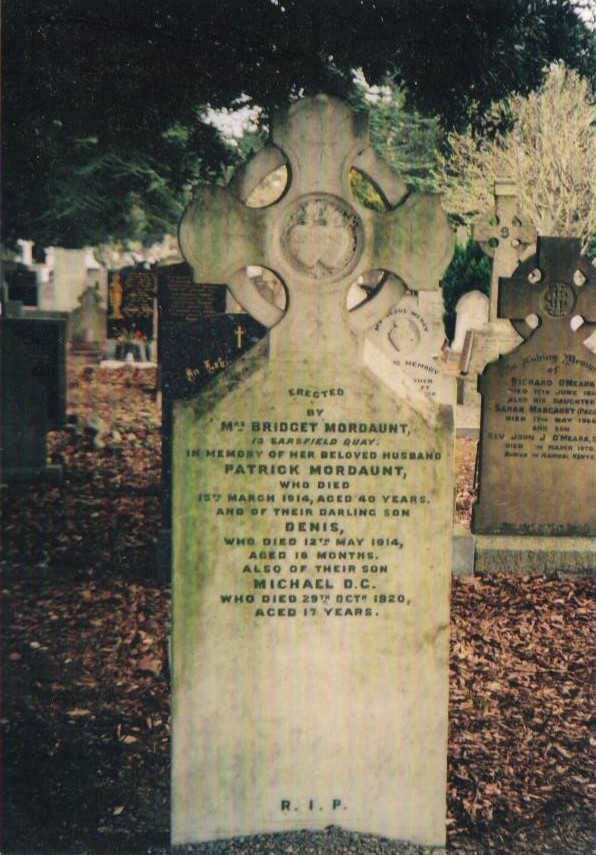|
|
Work in Progress
This page is regularly added to or corrected as I discover or am given more information. Any information you can provide about your family members, past or present, would be very welcome. Please forward to henry@mordaunt.me.uk.
This page was last amended in July, 2024.
"People who brag about their ancestors talk as if they had selected them themselves." (Anonymous)
Mordaunts and Mornings?
The Mordaunt Family in Ireland page describes in a little more detail that the few early records before 1840 almost invariably records Mordaunts as Mornings. Having heard the name pronounced in a strong rural Wexford accent, I can understand why. After the 1840s, they are usually recorded as Mordaunts
Great great great grandfather Patrick Mordaunt (mid 1700s - before 1825)
- Patrick Mordaunt, named as Patrick Morning in the few surviving records, appears to have occupied much of what is now the townland of Ballantlea. As such he was probably the "Morning" marked on the 1811 map of Gorey, distinguished enough to be named on the map but not distinguished enough for the courtesy title of Mr. or Esquire. The surviving baptism records name his wife as Mary. His holdings were divided between sons Patrick (whose baptism record has not yet been found) and Denis. The baptismal record of a daughter Elizabeth has also survived. By my calculations, based on my DNA test results, he is possibly the second generation of Mordaunts born in County Wexford. His grandfather Mordaunt, whoever that may have been, would therefore have been the first Mordaunt settler.
I am very grateful to my distant cousin, friend and fellow family history enthusiast Alison McCarthy for finding records of Patrick and forwarding them to me.
Great great grandfather Denis Mordaunt (December 1783 - 4th April 1868, aged 84 yrs)
- Denis Mordaunt ( 1783 - 4th April 1868) was baptised on 13th December, 1783, in the parish of Kilanerin - not the Pugin Gothic mid-19th century church there now. The Tithe Applotment Books of around 1825 list Denis Mordaunt holding 30 acres of land in the townland of Ballinclay. At the Griffiths valuation of around 1853, a Denis Mordaunt held land at renamed Ballintlea, Kilnahue, and a Denis Mordaunt held land at Clone, Monamolin. With the closely related Mordaunt families of Wexford all using the same few Christian names, it is possible that there were two Denis Mordaunt's about this time but, while bearing that possibility in mind, I think the few available clues point to there being only one. In the Griffiths valuation he was shown as joint tenant with Catherine Mordaunt (Patk). (which I assume means widow of Patrick), of 8 acres in Ballintlea occupied by Catherine Mordaunt (Geo), (again, widow of George Mordaunt?). The whole townland of Ballintea, all 237 acres, was held by Mordaunts, even if sublet to others (Griffiths valuation page 34 and page 35). Denis, Ellen (abt. 1791 - 1886), widow of Edward Mordaunt (abt. 1784 - 1852/3), the two Catherine Mordaunts (abt. 1790 - 1866 and abt. 1791 - 1871) and a Michael Mordaunt, suggesting a very close relationship between them all, brothers/sisters, cousins. That joint responsibility between Denis and Catherine (Patk) leads me to speculate that Denis and Patrick were brothers.
Denis would have been araound 15 years old when the 1798 rebellion swept through North Wexford in a surprisingly short space of time. On May 26th, the first armed encounter in the county occured at The Harrow, only two miles west of Clone, where Denis's landholdings were later recorded. On the following day, the battle of Oulart between insurgents and yeomanry, was fought only three miles south of Clone. Within days, Enniscorthy and Wexford had fallen. First the rebels, advanced north, committing atrocities against Protestants and loyalists and scavaging for food as they went and then the militia pushed them back south also committing atrocities, against Catholics, and scavaging for food as they went. The remnants took refuge on Vinegar Hill outside Enniscorthy where they were finally overrun on 21st June. The final insurgents in south County Wexford were defeated on 4th/5th July. All in less than six weeks! All this passed through whatever landholdings the Mordaunts held at the time. They seem to have come through it relatively unscathed, probably spared on the one side because they were Catholics and by the other because they were Anglo-Irish.
I am grateful to a Canadian correspondent, Jean Copland, who kindly wrote describing how the severity of the sectarian strife in this conflict affected her ancestors. They were from Gorey but were Anglican. She wrote "The Staples / Matchett forebears were badly affected by the '98 rebellion, to the tune of personal injuries and property damage. The old newspapers back in Co Wexford tell of the strife between the two religions. You are certainly correct in thinking that was why they up and came to Canada.
In Cavan, Ontario, there was a vigilante group called the Cavan Blazers, whose avowed purpose was to keep any Catholics out of the township. Many of the Blazers bore family names. I am certain it was fear of what massed Catholics were capable of, if they took a disliking to you, as they had back in Ireland, that got the Blazers up and kept them going. I believe the members of the Blazer group thinned out when those who'd been in Ireland around 1798 began to die off, and/or feel safer.
Even by 1900, the family didn't trust any Catholic on sight - they had to prove themselves to be peaceable people - it wasn't taken on trust. My mother, born 1908, was raised to be wary of Catholics; luckily she became a nurse, and met enough to grow out of that prejudice!"
I wonder if any of the Mordaunt landholdings recorded in the 19th century tithe applotment lists and the Griffiths Valuation had previously been occupied by Anglicans who had decided to up and leave the area?
For an brief guide to the 1798 rebellion visit this link
A Denis Morning was recorded marrying Mary Byrne (abt.1791 - 29th October 1851, aged 60 years) in Avoca, County Wicklow, in 1813 (the name Denis written in the priestīs best effort of writing the name in Latin). Once again, I am indebted to and infinitely grateful to Mary O'Dwyer for finding that marriage entry. Although Avoca was a little far from home I am as confident as I can be that it is the same Denis.
The next great event in Denis's life was the Great Famine, 1845 - 1849. Denis's landholdings would have been sufficient for him to see himself and family through the crisis. Cousins etc with smaller landholdings seem to have given up or lost their land.
While subleasing his holdings in Ballintlea, he is listed in the Griffiths Valuation as farming 105 acres in Clone West and Clone East, Monamolin, some 15 miles south. See this map of County Wexford. On his death certificate the cause of death was given as "apoplexy" which, acording to Wikipedia, was the usual term meaning death following a sudden loss of consciousness, such as an aneurysm, heart attack or stroke. He is buried in Boolavogue(Boleyvogue) cemetery, between Gorey and Enniscorthy. A parish record records his death, understating his age by 5 years
Some other random records available on genealogy websites shows that he was twice in court for allowing pigs to escape on to a public road, once in 1857, fined 6 pence with 1 shilling costs and once in 1861, fined 1 shilling with 1 shilling costs, and that in 1866 he paid for dog licences for three red mastiffs
Denis had a number of children, not necessarily listed here in total or in the correct order because of some vagueness over dates. I am confused because of a lack of certainty over many things, such as ages at death, so, where I lack definite information, I have relied on information passed down to me by my father. Where he got his information from I do not know.
- Miles Mordaunt ( 1817 - 21st June 1895) took over the land holdings of Denis in Ballintlea. He had been baptised in January, 1817 as Miles Morning in Ballyoughter parish. He was also in possession of the land in Ballintlea occupied previously by Cath(Patk) Mordaunt). The death certificate of Myles Mordaunt, a farmer from Ballantlea, wife Mary (Gahan), aged 78 is dated 21st June 1895. His tombstone gives his age as 76 years old. They were so vague about ages and dates then.
Miles is a further clue that Denis Mordaunt, above, of Clone, may be the same Denis Mordaunt of Ballintlea. In the rating valuation lists, land leased by Denis in Ballintlea from Francis Hatton was taken over by a Miles, He also took over land occupied previously by Cath(Patk) Mordaunt) also in the 1853 list. This change occured sometime before 1867 which ties in with the death of Denis in Clone.
- Miles is buried at Boolavogue cemetery, next to Denis. This is 16 miles from his home in days when travel was difficult. Other Mordaunts of Ballintlea are buried in a cemetery close to their homes.
- In 1982, Patrick Mordaunt, farming in Ballymurragh, described the Miles in Boolavogue cemetery as his uncle. This is impossible but it would fit in nicely if he was his fatherís uncle.
At the 1901 census, Mary, a widow, is listed at the farm with a nephew, Arthur Gahan. At sometime in the early 1900s the farm was occuped by her husband's nephew, Miles, son of Patrick Mordaunt. The 1911 census has an 80 year-old Mary Mordaunt living in Mullaunreagh, Monamolin, with her 86 year old brother Patrick Gahan.
Buried with Myles is his wife, Mary, and a niece Esther, given as aged 25 years old and intered 1912. Whose daughter she was I have no idea. They do not seem to have had any surviving children of their own.
- Michael Mordaunt (March 1819 - 31st March 1894) took over the land holdings of Denis in Clone East and West. He had been baptised on 25th March, 1819 as Michael Morning in Ballyoughter parish. Although Denis died in 1865, the rating valuation was not amended until about 1877. This is rather bad record keeping or there was another Denis. A Michael Mordaunt, described as a farmer from Clone, of full age, son of Denis Mordaunt, farmer, married Anne/Anna Murphy (abt. 1830 - 1904) on 12th November 1869. A Michael Mordaunt, a farmer from Clone, died 31st March 1894, age given 75 years old, which is unusually accurate in these records. The Registry entry gives cause of death as senile decay.
The rating valuation lists shows the farm in the name of Anne Mordaunt from about 1885, perhaps another example of tardy record keeping. In the 1901 census, a 70 year old Anna, with two servants, still lived on the farm. Her death was registered in Enniscorthy. Under the terms of Michael's Will, the farm then passed to his nephew, Thomas Doyle, son of his sister Catherine (with thanks to Mary O'Dwyer once again.
- Margaret Mordaunt married Mogue (or Moses or Moyses) Murphy. They had a farm at Mount Howard. My father passed down that she was headmistress of the local school. He descibed how the school was sited on the approach roads and when soldiers, or whoever, went past on the way to evict a farmer, the children would be sent scampering over the fields to raise the alarm. Regretably it is difficult to credit this colourful oral tradition since she was a farmerís wife with lots of children, born 1852,53,55,59,63,64 and maybe more, and would hardly have had much time to be the local teacher.
I am grateful to Mary Kenny, who contacted me in July 2013, for identifying Margaret as her great-great-grandmother. Mary is descended from a daughter of Margaret and Moses named Marcella, who married Owen Connolly of Templeshannon, Enniscorthy, in April 1884, in Monamolin.
- Mary Mordaunt married a Peter Laffin. These two sisters, Margaret and Mary, were particularly useful to my research as between them they had a stream of children baptised in the local church for whom their brothers and sisters acted as godparents.
- Catherine Mordaunt was godmother to a sisterís baby in 1849. I had written on this site that I had found no further information about her but now I am again grateful to Mary O'Dwyer who, continuing her own research into her own, closely related family, forwarded to me a copy of Catherine's Will, written in October 1869, as recorded in the National Archives. She married William Doyle (d. 1868/69), a farmer and miller, and had two surviving children, Thomas Doyle and Lizzie Doyle. After the death of his aunt, Anne, Thomas inherited the family farm in Clone East and West under the terms of his uncle Michael's will, (see above)
- Charles Mordaunt I have very little information on Charles. He was godfather to a sisterís baby in 1852. According to family oral tradition passed to me by my father, Charles went to the USA where he was popularly believed to have made his fortune. A Charles Mordaunt, born in Ireland in about 1830, is shown in the 1870 US Census as living in New York with his wife Jane, aged 38, also from Ireland. They do not reappear in later censuses. (There need be nothing ominous in this; the census records I have found on the Internet are very incomplete.) A surviving passenger list of the SS Etruria in 1888 shows a Irish passenger Charles Mordaunt travelling to New York. He was given as 62 years old and so born in 1826. I am again grateful to Mary O'Dwyer who discovered a copy of his death certificate, 1st October, 1892, where his age was now 58 years.
- Edward Mordaunt (abt. 1831 - 1917), my great grandfather, was godfather to a sisterís babyís in 1855.
- Patrick Mordaunt (abt. 1834 Ė 1892) was a godfather to a sisterís baby in 1854. His wife was Ellen Crowe (1838-1899). At some time, Patrick occupied the farm at Ballymurragh and had, among any other children:
- Denis Mordaunt, (abt. 1860 - ?). Curiously, in the 1901 census, his brother Michael named head of the family, Denis listed after as a farmer's son.
- Mary Mordaunt, (18th January 1864 - ?). Either she died young and a later daughter was also called Mary or the date given in the English census records for Mary, Sister of Charity, below, is well out.
- Michael Mordaunt (b. 1866 - ?). Curiously, in the 1901 census, he was named head of the family over his older brother, Denis. Johanna and Myles were also in the house. He was in possession of the farm at the 1911 census with his wife Mary. His brothers and sisters had moved on.
- Patrick Mordaunt (1915 - ?). I visited Patrick at Ballymurrugh in 1982 and met his children:
- Michael Mordaunt (b. 1958)
- Charles Mordaunt (b. 1959)
- Mary Mordaunt (b. 1961)
- Olive Mordaunt (b. 1964)
- Elizabeth Mordaunt, (15th February 1867 - ?) was a Sister of Charity teaching St Paul the Apostle, 2 Monkgate, York, at the 1891 English census, the 1901 English census and the 1911 English census.
- Margaret Mordaunt, (24th February 1869 - ?). She presumably died young as another Margaret was registered in 1879
- Ellen Mordaunt, (27th January 1871 - ?). An Ellen Mourdant (sic), aged 20 years, appears in the 1891 English census as a teacher at a convent school in Batley, Yorkshire, presumably our Ellen. It is not clear if she was a member of a religious order like her sisters.
- Johanna Mordaunt, (25th April 1873 - 1947).
 She married James Sinnott (1850 - 1916) and they lived in Bolaboy More, Ballaghkeen South. They had eight children, twin girls, a boy, twin girls again, two boys and another girl. I am grateful to Mary O'Dwyer for contacting me with information about Johanna's marriage and family and for sending this photo of Johanna, James, and the five eldest children. Mary's grandmother, Ellen Sinnott (1904 - 1982), one of the twins, was Johanna and James's second eldest daughter and called after her maternal grandmother. Mary has found that, sadly, all the boys died as children She married James Sinnott (1850 - 1916) and they lived in Bolaboy More, Ballaghkeen South. They had eight children, twin girls, a boy, twin girls again, two boys and another girl. I am grateful to Mary O'Dwyer for contacting me with information about Johanna's marriage and family and for sending this photo of Johanna, James, and the five eldest children. Mary's grandmother, Ellen Sinnott (1904 - 1982), one of the twins, was Johanna and James's second eldest daughter and called after her maternal grandmother. Mary has found that, sadly, all the boys died as children
- Myles Mordaunt, (25th August 1874 - 29th June 1946). I am grateful to his grandson, Myles Mordaunt who kindly contacted me to confirm that this was the Myles Mordaunt listed in the 1911 census, farming in Ballintlea. He seems to have taken over the farm, formerly held by his his grandfather Denis and then his uncle Myles, from Myles's widow, Mary, sometime after 1900. Anyway, his wife was Maggie (abt. 1885 - 8th May 1951) and they had children
- Patrick Mordaunt (abt. 1904 - 27th October 1967). He inherited his father's farm but, being a batchelor, it was finally passed on to a son of his sister, Ellen. He is buried with his parents in Craanford Cemetery
- Ellen Mordaunt (abt. 1906 - ). One of her son's was to inherit the farm at Ballintlea.
- Bridget Mordaunt (abt. 1907 - 25th November 1928). Her nephew, Myles, told me that she died of TB. The tombstone apparently gives her age as 17 years (d.o.b. abt. 1911) which does not fit with the 1911 census (d.o.b. abt. 1907).
- Mary Mordaunt (abt. 1910 - 7th July 1929). Her nephew, Myles, told me that she died of TB. The tombstone apparently gives her age as 15 years (d.o.b. abt. 1914) which does not fit with the 1911 census (d.o.b. abt. 1910).
- Myles Mordaunt (1914 - 1855). In 1943 he and his family moved to Rosslare Strand. Among any other children he may have had was
- Myles Mordaunt (b. ?) who moved to west London and married Rosalyn MacEntee in Ealing in 1964. They lived in Hayes, Middlesex, before returning to Ireland on his retirement in 2002.
- daughter Mordaunt (name withheld on request) (b. 1967) Her birth was registered in Hillingdon.
- daughter Mordaunt (name withheld on request) (b. 1975). Her birth was registered in Hillingdon.
I am very grateful to Myles who kindly contacted me to inform me that it was his grandfather Myles who took over Denis Mordaunt's land holdings in Ballintlea and to give me a great deal more information about the family, especially those buried in Craanford and Monaseed, taken from records prepared by those parishes..
- A Denis Mordaunt, who "died young" is buried with his parents. He is presumably the son that his nephew Myles told me died in a farming accident
- daughter Mordaunt, (12th June 1876 - ?), whose birth was registered.
- Margaret Mordaunt, (26th July 1879 - ?) who was a Sister of Charity teaching at St Patrick's convent, York Road, Leeds, according to the 1911 English census.
- Mary Mordaunt, (abt. 1880 - ?) was a Sister of Charity of St Paul in St Paul's Convent, Kings Norton, Worcestershire, at the 1901 English census. I have not found her in the 1911 English census.
- Esther/Hester Mordaunt (abt. 1843 - 1881). The names Esther and Hester seem interchangable at these times. Anyway, I am grateful to Helen Rath who very kindly wrote to inform me that Esther Mordaunt of Clone married Francis Rath of Garrydaniel on 15th September 1869. Helen's grandfather's cousin. This fits in with the record of the marriage of a Hester Mordaunt registered in Enniscorthy district in 15th September 1869. Helen writes they travelled to Argentina "where it appears they farmed extensively. She died in 1881 and is interred in the Mordaunt Family plot marked with a headstone erected by her husband, Francis."
- Patrick Rath, (abt. 1871 - late 1930s). He was "aged about 8 years when his mother died and he was sent home to Ireland to be educated in Clongowes Wood College." He was the Paddy Rath, fellow student at Clongowes Wood College, fleetingly referred to in James Joyce's "Portrait of the Artist as a Young Man." He later played for Bective Rangers Football Club. He married a Miss Murtagh but they had no chidren. His funeral in the late 1930s, as well being attended by former Taoiseach W. T. Cosgave and his wife, was attended by his cousins Denis and Michael, but I can only guess as to which cousins Denis and Michael they could have been.
- Johanna Mordaunt and
- Rose Mordaunt were godparents in 1859. I know nothing more about them.
The family would have lived through The Great Famine (1846/49). Caused by the failure of the potato crop, those who were tenant farmers of a reasonable sized plot would have been cushioned from the worst effects of the calamity. Denis's holdings of 105 acres would have been large for the time and indicate that his family was comparatively safe. In 1845, as an example, 24% of all Irish tenant farms were of one to five acres (0.4 to 2 hectares) in size, while 40% were of five to fifteen acres (2 to 6 hectares). A British Government report carried out shortly before the Great Hunger noted that the scale of the poverty was such that one third of all small holdings in Ireland were presumed to be unable to support their families, after paying their rent, other than through the earnings of seasonal migrant labour in England and Scotland. (Thanks to Wikipedia for that bit.)
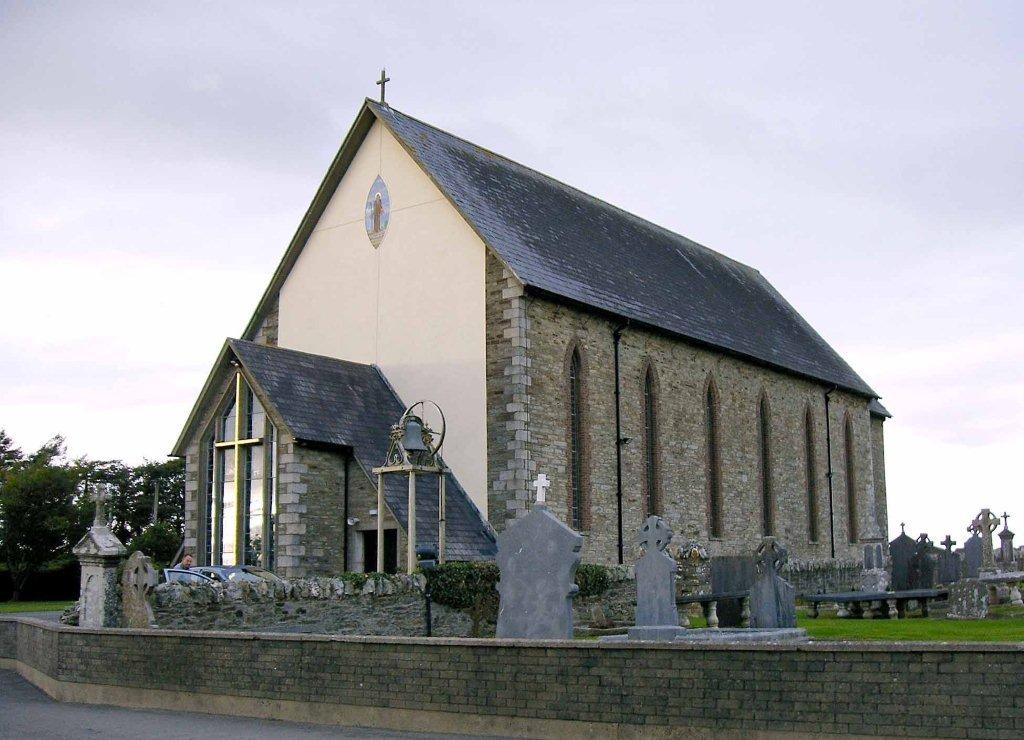
Boolavogue cemetery
Mordaunt graves
in the left corner |
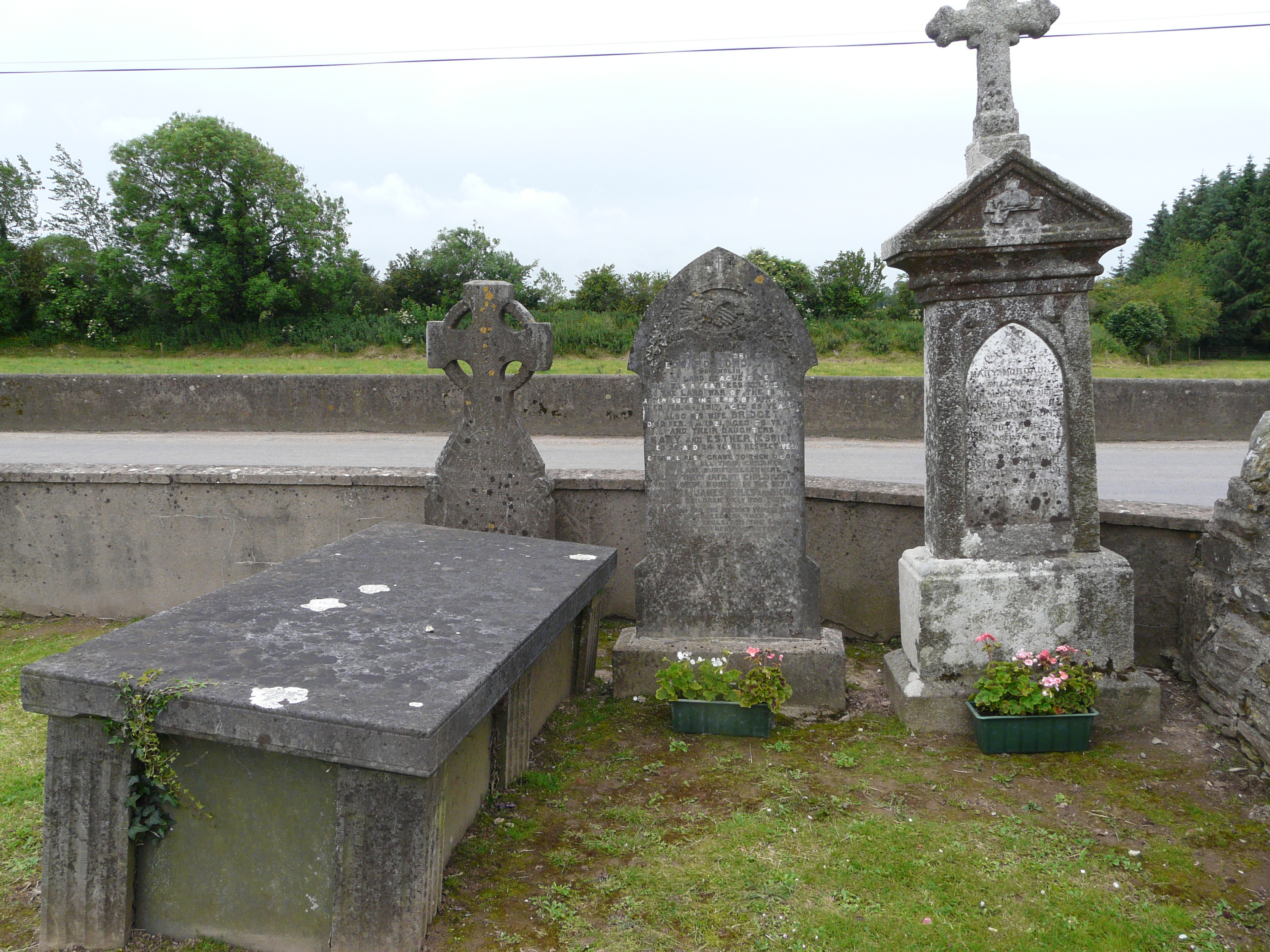
Family plot (l to r)
Denis snr., Esther,
Edward, Myles |
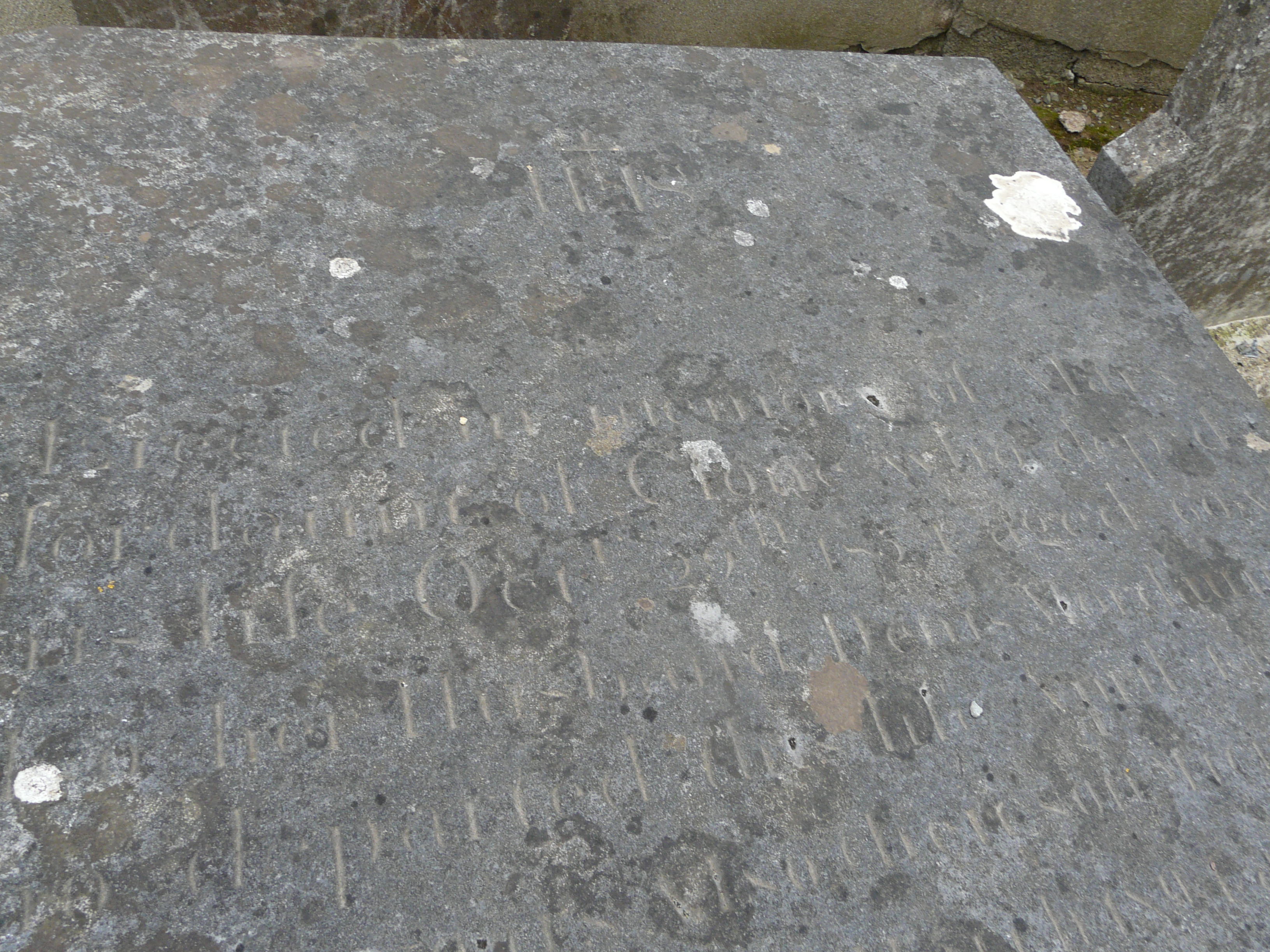
Denis and Mary
|
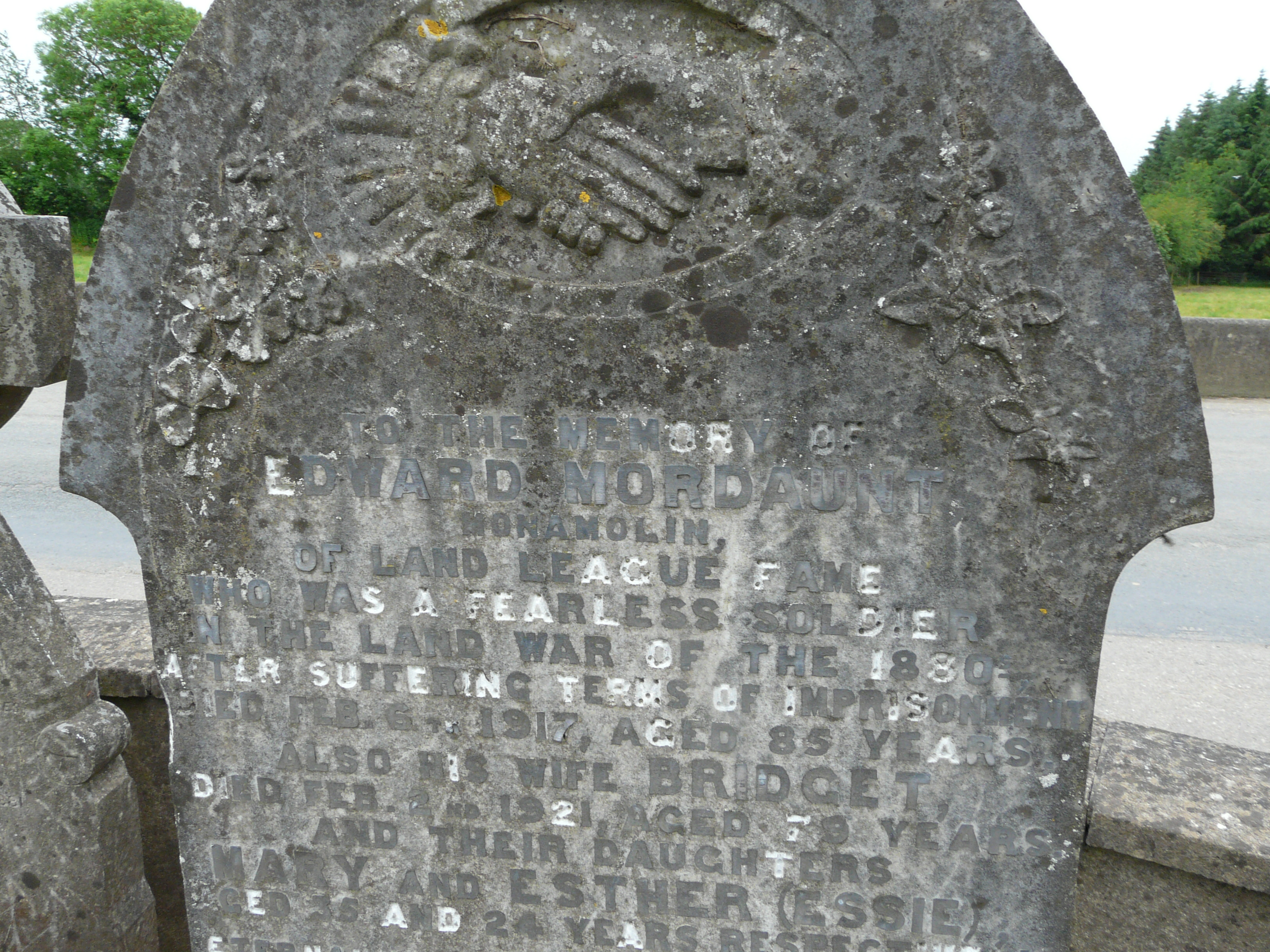
Edward and Bridget
|
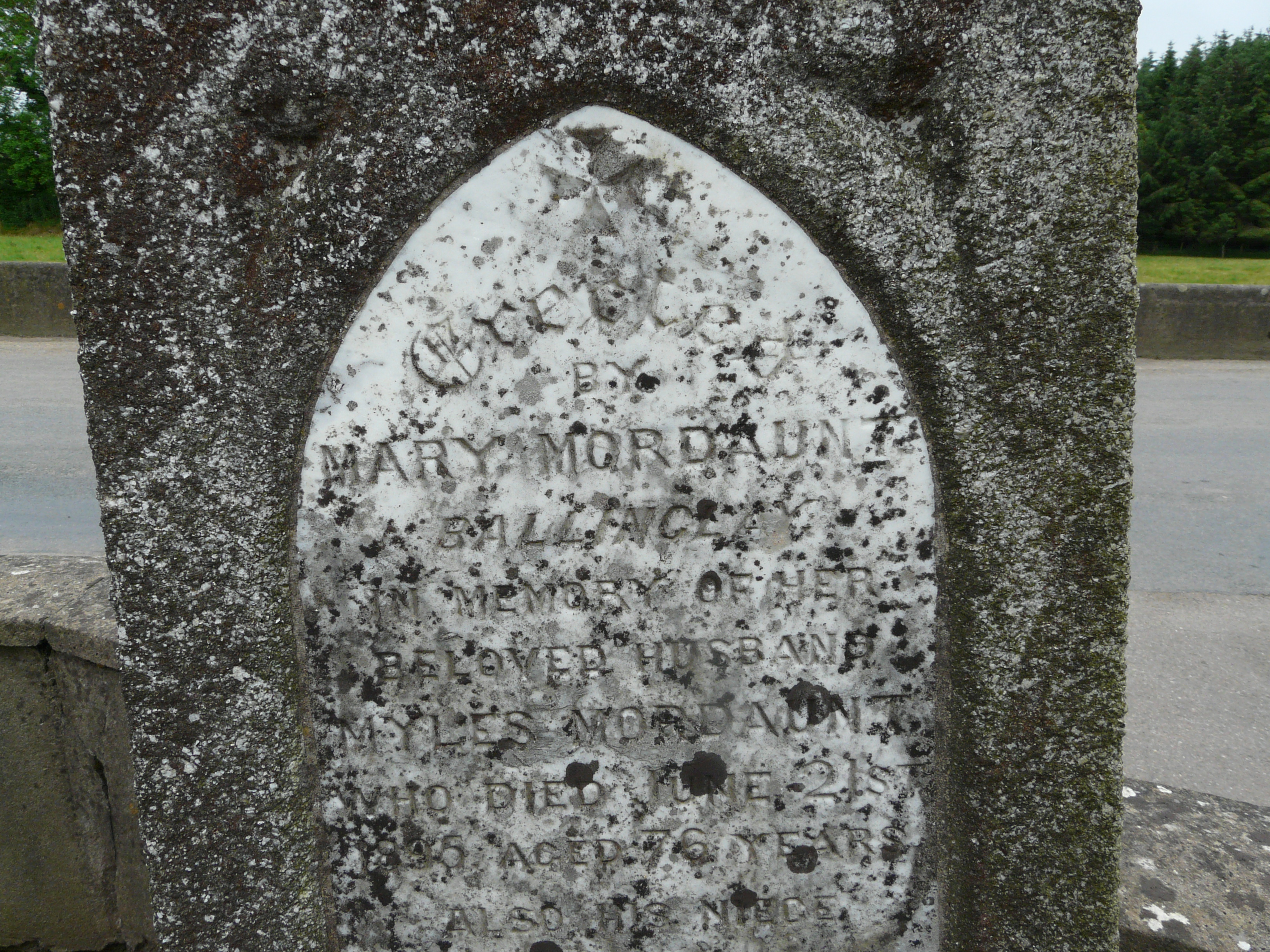
Myles
|
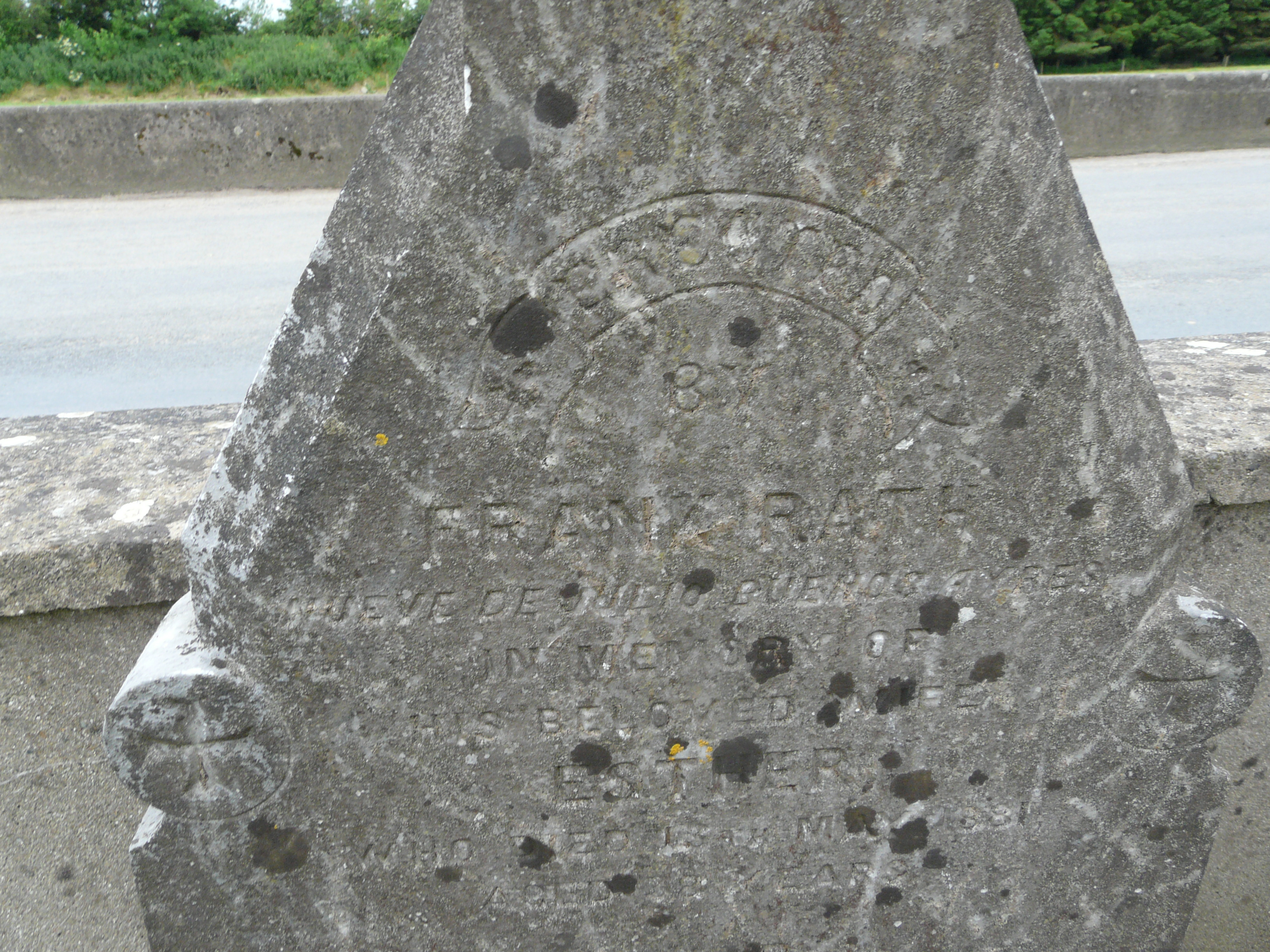
Esther
|
Photographs courtesy of Myles Mordaunt and Sarah Rath
Fr. Mike Byrne, curate, of Boolavogue in 2012 kindly sent me the following inscriptions
- Erected in the memory of Mary Mordaunt, Clone, who departed this life Oct 29th 1851 aged 60yrs
Also her husband Denis Mordaunt who departed 11th ? April 1868 aged 79yrs.
Their daughter-in-law Ellen Mordaunt, Died Sept 6th 1899 aged 80yrs ?. Their son Patrick Mordaunt died Oct 9th 1894 aged 63yrs. Also his grandson Denis Mordaunt died March 13th 1932 aged 72yrs. Their daughter-in-law Bridget Mordaunt died Feb 6th 1917 aged 76yrs.
- To the memory of Edward Mordaunt of Land League fame who was a fearless soldier in the land war of the 1830 after suffering terms of imprisonment died Feb 1917 aged 85yrs.
Also his wife Bridget died Feb 2nd 1921 aged 79yrs and their daughters Mary & Esther (Essie) aged 35 & 24yrs respectively. Eternal rest grant unto them O'Lord and to all their children who are buried elsewhere. Also their infant children who were buried in the 1870s, Johanna, James, Myles & Michael. "Little children pray for them, St. Joseph and the Virgin Mary interceed for them. May their souls and the souls of all the faithful departed rest in peace Amen".
- Erected by Mary Mordaunt, Ballinclay, in memory of her beloved husband Myles Mordaunt who died June 21st 1895 aged 76yrs. Also his niece Esther Mordaunt who died Oct 14th 1912 aged 23yrs.
From the photograph, Esther's inscription is
- Erected by Francis Rath, Neuve de Julio Buenos Ayres, in memory of his beloved wife Esther who died 13th May 1881 aged 38 years. (Nueve de Julio, named after the date of Argentina's declaration of independence, is a city in Buenos Aires province, Argentina, presumably the family home in Argentina)
Great grandfather Edward Mordaunt (abt. 1831 - 6th February, 1917)
- Edward Mordaunt (abt. 1831/32 - 6th February, 1917). He died in February 1917, believed to be 85 and so was born about 1831. He is listed in Litter parish register as marrying Bridget Crowe (abt.1841 - 2nd February, 1921) on 15th November 1863. By 1864 he was in occupation of 86 acres at Cullentra.
Edward ceased occupation of Cullentra for non-payment of rent in 1886 during the "land war." At the time of his eviction, Edward had ten surviving children, aged from 5 or 6 to 24 years old. The farm was allocated to a Johnson family
land war - period of agrarian agitation from 1879 - 1903. The land war began in 1879 with a meeting in Irishtown, Co. Mayo, and ended with the passing of the Land Act 1903, the 'Wyndham's Act. This was the culmination of a series of acts designed to bring about the transfer of ownership of tenanted lands from landlord to tenant - the principal goal of the agitation. The land war went through three periods, each associated with national organisations that mobilised the discontent in the Irish countryside; 1879 - 81, Irish National Land League; 1882 - 1991, Irish National League and 1898 - 1903, United Irish League.
(Donald Jordan, Professor of History at Menlo College, Californa, for 'The Encyclopaedia of Ireland,' General Editor Brian Lalor, Gill & MacMillan 2003)
When the reform finally came the beneficiaries were not the casualties of the war, those who had been evicted from their farms, but those occuping the farm at the time who were granted tenancy of the land afterwards. This may explain the resentment that still existed towards the Johnson family that was still apparent on my visits to the area in the 1950s and in 1982. The original house was destroyed by fire in the 1970s and I was told it was popularly believed to be a revenge attack!
I found a number of newspaper reports on Edward Mordaunt, courtesy of, of all places, the New Zealand National Library, whose Internet archives include copies of past editions of "The New Zealand Tablet" which carried news items from the UK for the benefit of its homesick readers. Then, I am grateful to correspondent, Professor Ged Martin, who referred me to other more local newpaper sources. I ended with so many that I decided to reproduce them on their own page.
Edward ended his days as keeper of a small shop in Monamolin which my father once told me had been bought for him by public subscription. In the 1901 census, Edward, Brigid and Esther (Essie) were living at house 3 in Court Ballyedmond, Monamolin. Denis, Michael and Charles were in Dublin. Patrick was in the army and Margaret was working as a seamstress, both in Canterbury, England. The Johnson family are not recorded at Cullentra in the 1901 census; the enumerator did not acknowledge their existence. The enumerator for the 1911 census went even further. Again, the Johnson family in Cullentra are not recorded. Edward's profession was given as "farmer & shopkeeper" and, although the address given is the shop, the premises described are clearly also those of the farm, with a stable, a cow house, a piggery, a fowl house and a shed. There are no Johnsons listed in Cullentra; Edward is still given as the occupier of the farm, twenty two years after his eviction!
Living 'at home' at the 1911 census were Michael, whose profession was described as "farmer's son"(!) and Essie.
On Edward's death, his son Denis had a memorial erected in Boolavogue cemetery
"In memory of Edward Mordaunt, Monamolin, of Land League fame, who was a fearless soldier in the Land War of the 1880s. After suffering terms of imprisonment died Feb. 6th, 1917. Aged 85."
The baptisms of their children are recorded in Monamolin parish records. The 1911 census records that Edward and Bridget had had a total of 13 children of whom 8 had survived. There seem to have been two Johannas.
- Denis Mordaunt (18th March 1865 - 1941). His birth was recorded in Killenagh and Wells. In the 1901 census he was an assistant grocer, living with his employer, Henry Butler, in Portobello Road, Wood Quay. He is described in the 1911 census was now grocer's manager, Henry Butler having apparently died. My father told me Denis ended up with two shops in Dublin. A photograph I was told was of Denis showed him as a properous man, well fed, well clothed with two gorgeous setters at his feet. I do not know what happened to that photo. He erected the monument to his father in Boolavogue Cemetery. His death was registered in Dublin South district.
- Mary Mordaunt (12th June 1866 - abt.1901). Her birth was recorded in Killenagh and Wells. She does not seem to have married and is interred in her parent's grave in Boolavogue cemetery, her age given as 35 years. She presumably died shortly before the 1901 census as she was not listed there.
- Catherine Mordaunt (abt.1867 - ?) A Catherine Mordaunt aged 20, father Edward, a farmer, married James Rourke on 30th April, 1887. If she was this Catherine, why did they marry in Enniscorthy?
- Johanna Mordaunt (? - 1870s). Her name is listed on her parents' tombstone.
- James Mordaunt (27th October 1869 - 1870s). His name is listed on his parents' tombstone.
- Myles Mordaunt (9th June 1871 - 1875) died when he was 4 years old.
- Michael Mordaunt (11th December 1872 - 1875).
- Patrick Mordaunt (10th March 1874 - 1914), my grandfather
- Michael Mordaunt ( 21st August 1875- ?). In the 1901 census he was recorded with his brother, Charles, as a vintner's assistant working for and boarding with Thos.H. Hickery at Ballsbridge Terrace, Pembroke West. At the 1911 census he was living at home with his parents. He died a bachelor after continuing to mind the Monamolin shop for a few years after the death of his father. My father's memory of him from that period was that he drank too much.
- Johanna Mordaunt (7th April 1877 - abt. 1892). This appears to be a second Johanna. A Johanna Mordaunt died, aged 14 or 15, in Enniscorthy Lunatic Asylum. (The hospital still exists, or at least it did when I was in the area in 1982, though under a new name kinder to our modern ears. In this overwhelmingly rural area, there were over 400 patients there in the 1890s according to a contemporary newspaper report, a remarkable number by today's considerations, although, possibly, it doubled up as a local general hospital).
- Margaret Mordaunt (20th May 1879 - ?) was working as a seamstress living in Canterbury with her brother Patrick in the 1901 UK census (page 1 continued on page 2) at the time of my father's birth. She is probably the adult sitting in the centre of the photograph below. Although the age given is wrong, she must be the Margaret Mordaunt recorded in the 1911 census, born in Monamolin, and working as a drapery shop assistant in Deal, Kent. She married a teacher, Michael McConneloge, in Dublin on 21st July, 1915. (With more thanks to Mary O'Dwyer for the copy of the record)
- Esther (Essy) Theresa Mordaunt (abt.1881 - abt.1906) was living with her parents at the 1901 census, helping in the shop, her age given as 18 years old. She was described as aged 25 on the shared tombstone shared with her parents at Boolavogue cemetery.
- Charles Mordaunt, (24th May 1883 - June 9th 1835?). In the 1901 census he was recorded with his brother, Michael, as a vintner's assistant working for and boarding with Thos.H. Hickery at Ballsbridge Terrace, Pembroke West. He joined the 5th Royal Royal Irish Lancers on 2nd September 1902 (I served two years attached to their successor regiment, the 16th/5th Queen's Royal Lancers 1969/71; I wish I had known this fact at the time) but only lasted for some 21 days and bought himself out. He then joined the Royal Irish Rifles as 7063 Pte. C. Mordaunt. (For his British Army service here I am very grateful to Doug Vaugh who kindly wrote to me with the information). He then seems to disappear from the UK records but my father knew he had gone to the US and a Charles Mordaunt arrived on Ellis Island on 30th May 1912, aged 27 and described as English-Irish. This is probably he although the age would be two years out. His US draft WW I registration (resident in Manhatton, previous occupation bar keeper) is dated 12th September 1918, making his actual participation in the war unlikely. However, my father passed on the family belief that he fought in WWI as an officer in the US 59th Infantry Regiment. Perhaps he spun a few yarns to his family. A Charles Mordaunt passed through Ellis Island again from Londonderry in February 1920. He is quite possibly the same Charles visiting home with his tall stories. I hope I am not being too hard on him! I haven't found any Charles Mordaunt in the US Census records for 1920 and 1930. He is possibly the Charles Mordaunt whose death was listed in The Bronx in 1935, age given as 51 years.
Grandfather Patrick Mordaunt (10th March 1874 - 15th March 1914)
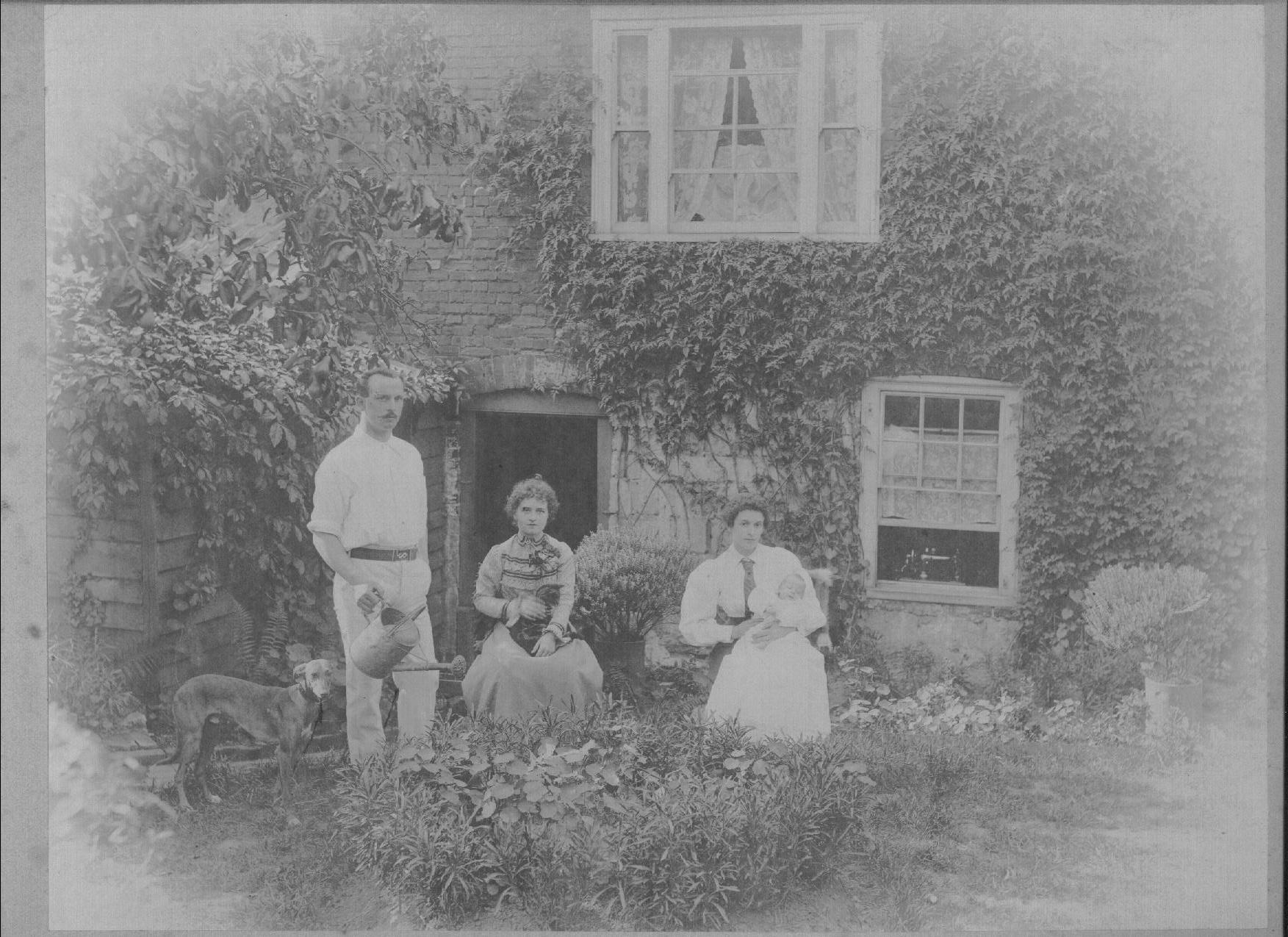 He joined a cavalry regiment of the British Army (18th Hussars) and rose to the rank of Warrant Officer. As far as I know, he spent much of his service life in England; my father, for example, was born in barracks in Canterbury, one of my uncles in York. He clearly avoided the Boer War fought in that period as at the time of my father's birth the regiment was holed up in Ladysmith during the famous seige. In his service he won more awards for mounted swordsmanship that any other non-commissioned officer in the Army. He married Bridget (var. Brigid) Plunket (13th May 1873 - 10th December 1957) in 1898 in Wexford and they had seven children. In the 1901 UK census (page 1 continued on page 2) he was stationed in Canterbury, where my father was born. Soon after 1905 he was transferred or seconded to the South Irish Horse militia regiment, probably in Co. Kildare, where the later children were born, and Dublin (again thanks to Doug Vaugh for this bit of information). He was recommended for the award of the Long Service and Good Conduct medal on 1st July 1909. In the 1911 census he was recorded living at Beggarsbush Barracks, Pembroke West, with Bridget and the first five of their surviving children. He died of an illness aged 40.
He joined a cavalry regiment of the British Army (18th Hussars) and rose to the rank of Warrant Officer. As far as I know, he spent much of his service life in England; my father, for example, was born in barracks in Canterbury, one of my uncles in York. He clearly avoided the Boer War fought in that period as at the time of my father's birth the regiment was holed up in Ladysmith during the famous seige. In his service he won more awards for mounted swordsmanship that any other non-commissioned officer in the Army. He married Bridget (var. Brigid) Plunket (13th May 1873 - 10th December 1957) in 1898 in Wexford and they had seven children. In the 1901 UK census (page 1 continued on page 2) he was stationed in Canterbury, where my father was born. Soon after 1905 he was transferred or seconded to the South Irish Horse militia regiment, probably in Co. Kildare, where the later children were born, and Dublin (again thanks to Doug Vaugh for this bit of information). He was recommended for the award of the Long Service and Good Conduct medal on 1st July 1909. In the 1911 census he was recorded living at Beggarsbush Barracks, Pembroke West, with Bridget and the first five of their surviving children. He died of an illness aged 40.
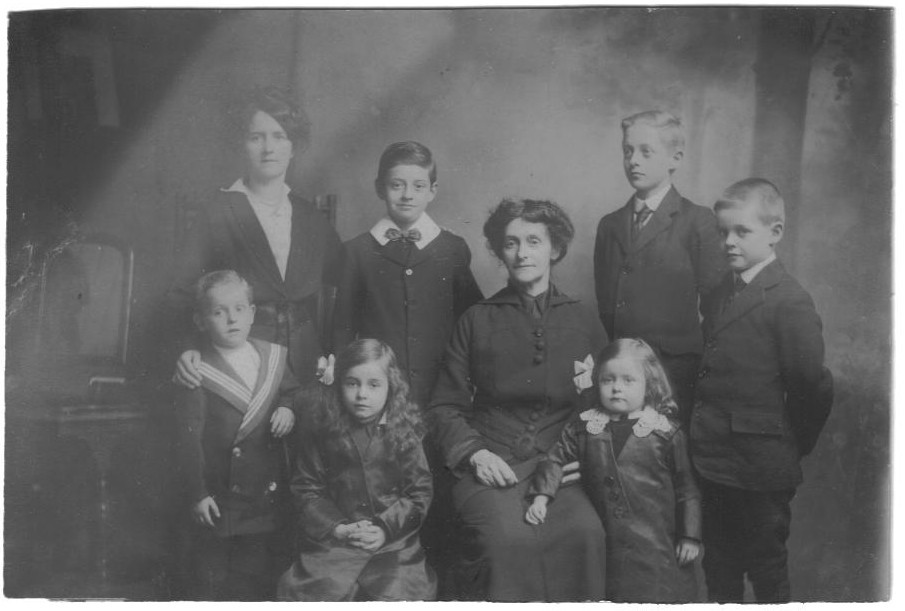
Family group after the death of father, Patrick, and after the funeral of baby Denis.
From the left to right: Patrick, Aunt Margaret, Molly, Michael, mother (Bridget), Brigid, Edward and Myles
|











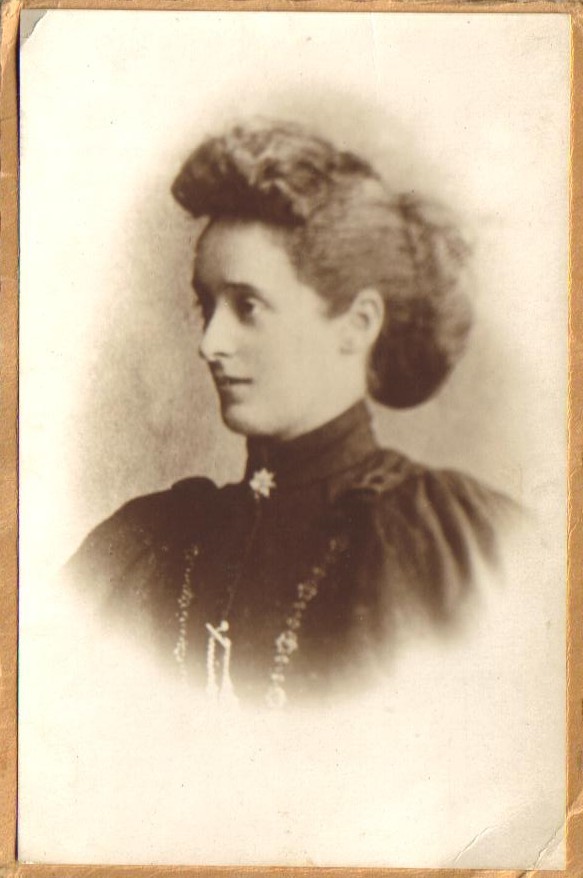


.jpg)
.jpg)








.jpg)

